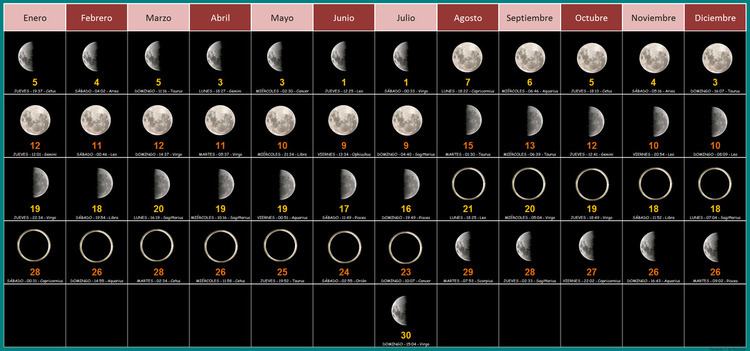 | ||
A lunar calendar is a calendar based upon cycles of the Moon's phases (synodic months), in contrast to solar calendars based solely upon the solar year. A purely lunar calendar is also distinguished from lunisolar calendars whose lunar months are brought into alignment with the solar year through some process of intercalation. The details of when months begin varies from calendar to calendar, with some using new, full, or crescent moons and others employing detailed calculations.
Contents
Because each lunation is a little less than 29 days, 12 hours, 44 minutes, and 3 seconds (29.530588 days), it is common for the months of lunar calendars to vary between 29 and 30 days. Because the period of twelve such lunations—a lunar year—is a little less than 354 days, 8 hours, 48 minutes, and 34 seconds (354.367056 days), purely lunar calendars lose around 11 days per year relative to the Gregorian calendar. In purely lunar calendars such as the Islamic calendar, the lack of intercalation causes the lunar months to cycle through all the seasons of the gregorian year over the course of a 33-lunar-year cycle.
Although the Gregorian calendar is in common and legal use in most countries, traditional lunar and lunisolar calendars continue to be used throughout the Old World to determine religious festivals and national holidays. Such holidays include Ramadan (Islamic calendar); the Chinese, Japanese, Korean, Vietnamese, and Mongolian New Year (Chinese, Japanese, Korean, Vietnamese, and Mongolian calendars); the Nepali New Year (Nepali calendar); the Mid-Autumn Festival and Chuseok (Chinese and Korean calendars); Loi Krathong (Thai calendar); and Diwali (Hindu calendars).
History
The earliest known lunar calendar was found at Warren Field in Scotland and has been dated to c. 8000 BC, during its Mesolithic period. Some scholars argue for lunar calendars still further back—Rappenglück in the marks on a c. 17,000-year-old cave painting at Lascaux and Marshack in the marks on a c. 27,000-year-old bone baton—but their findings remain controversial.
Lunisolar calendars
Most calendars referred to as "lunar" calendars are in fact lunisolar calendars. Their months are based on observations of the lunar cycle, with intercalation being used to bring them into general agreement with the solar year. The solar "civic calendar" of ancient Egypt showed traces of its origin in the earlier lunar calendar, which continued to be used alongside it for religious and agricultural purposes. Present-day lunisolar calendars include the Chinese, Hindu, and Thai calendars.
Synodic months are 29 or 30 days in length, making a lunar year of 12 months about 11 days shorter than a solar year. Some lunar calendars do not use intercalation, such as most Islamic calendars. For those that do, such as the Hebrew calendar, the most common form of intercalation is to add an additional month every second or third year. Some lunisolar calendars are also calibrated by annual natural events which are affected by lunar cycles as well as the solar cycle. An example of this is the lunar calendar of the Banks Islands, which includes three months in which the edible palolo worm mass on the beaches. These events occur at the last quarter of the lunar month, as the reproductive cycle of the palolos is synchronized with the moon.
Start of the lunar month
Lunar and lunisolar calendars differ as to which day is the first day of the month. In some lunisolar calendars, such as the Chinese calendar, the first day of a month is the day when an astronomical new moon occurs in a particular time zone. In others, such as some Hindu calendars, each month begins on the day after the full moon or the new moon. Others were based in the past on the first sighting of a lunar crescent, such as the Hebrew calendar.
Length of the lunar month
The length of each lunar cycle varies slightly from the average value. In addition, observations are subject to uncertainty and weather conditions. Thus to avoid uncertainty about the calendar, there have been attempts to create fixed arithmetical rules to determine the start of each calendar month.
The average length of the synodic month is 29.530589 days. Thus it is convenient if months are in general alternately 29 and 30 days (sometimes termed respectively hollow and full). The distribution of hollow and full months can be determined using continued fractions, and examining successive approximations for the length of the month in terms of fractions of a day. In the list below, after the number of days listed in the numerator, an integer number of months as listed in the denominator have been completed:
29 / 1 (1 day after about 2 months)30 / 1 (1 day after about 2 months)59 / 2 (1 day after about 2.6 years)443 / 15 (1 day after about 30 years)502 / 17 (1 day after about 70 years)945 / 32 (1 day after about 122 years; expressible exactly in binary: 11101.10001₂)1447 / 49 (1 day after about 3 millennia)25101 / 850 (dependent on change of synodic month value)These fractions can be used to construct a lunar calendar, or in combination with a solar calendar to produce a lunisolar calendar. A 49-month cycle was proposed as the basis of an alternative Easter computation by Isaac Newton around 1700. The tabular Islamic calendar's 360-month cycle is equivalent to 24×15 months minus a correction of one day.
